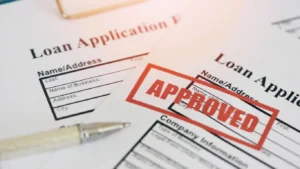Motorcycle repossession can be very stressful. But knowing what happens and your rights can help. In this guide, we’ll cover what happens when your motorcycle is repossessed. We’ll also talk about the immediate and long-term effects and how to protect yourself and your credit.

Key Takeaways
- Motorcycle repossession is when a lender takes back a motorcycle because of missed payments or default on the loan.
- Common reasons include late or missed payments, defaulting on the loan, or breaking the loan terms.
- Repossession can lead to losing your motorcycle and extra fees right away. It can also hurt your credit score in the long run.
- You have legal rights as a borrower. It’s key to know them during repossession.
- By negotiating with the lender, managing your finances, and rebuilding your credit, you can get through a motorcycle repossession.
Understanding Motorcycle Repossession
Motorcycle repossession is a complex issue many borrowers face. It happens when a lender takes a motorcycle because the borrower didn’t make payments. Knowing what motorcycle repossession is and why it happens is key to dealing with it.
What Is Motorcycle Repossession?
Motorcycle repossession is when a lender, like a bank, takes back a motorcycle. This happens when the borrower misses payments or breaks the loan agreement.
Common Reasons for Repossession
There are several reasons a motorcycle might be repossessed. The main reasons include:
- Missed or late loan payments
- Defaulting on the loan agreement
- Violating the terms of the loan contract, such as using the motorcycle for illegal activities
- Failing to maintain the required insurance coverage
- Providing false information on the loan application
Understanding motorcycle repossession and its common reasons helps borrowers prepare and navigate this tough situation.
“The best way to avoid motorcycle repossession is to make timely payments and stay in communication with your lender if you’re facing financial difficulties.”
The Repossession Process
Understanding the motorcycle repossession process is key. It starts when a borrower misses loan payments. The lender or a repossession agency may take the motorcycle without asking. They can get it from your home, work, or anywhere it’s found.
The steps in the repossession process are as follows:
- Notice of Default: The lender sends a notice when payments are missed. It explains what the lender can do next.
- Repossession: If payments aren’t made, the lender or agency takes the motorcycle. This can happen anytime, without telling you.
- Notification of Repossession: After taking the motorcycle, the lender must tell you in writing. They explain your rights to the vehicle.
- Sale of the Motorcycle: The lender sells the motorcycle. They use the money to pay off the loan.
Knowing the motorcycle repossession process helps if you’re struggling financially. It lets you prepare and find ways to avoid losing your motorcycle.
| Step | Description |
|---|---|
| Notice of Default | The lender sends a notice when payments are missed. |
| Repossession | The lender or agency takes the motorcycle without asking. |
| Notification of Repossession | The lender tells you in writing about the repossession and your rights. |
| Sale of the Motorcycle | The lender sells the motorcycle, usually through a public or private sale. |
“Understanding the motorcycle repossession process is crucial for borrowers facing financial difficulties.”
What Happens If My Motorcycle Gets Repossessed
When your motorcycle is repossessed, it can change your life a lot. Knowing what might happen is key to handling it well.
Immediate Consequences
Getting your motorcycle repossessed brings big problems right away. You might not have a way to get to work or do daily tasks. You also have to pay fees for the repossession, which can hurt your wallet even more.
Long-Term Effects
The impact of motorcycle repossession goes beyond just losing your bike. It can hurt your credit score, making it hard to get loans later. This could limit your financial options and chances.
Also, a repossession can make you feel financially unstable and stressed. This stress can affect your mental health and overall life quality.
“The consequences of a motorcycle repossession can be far-reaching and long-lasting, but with the right approach, you can navigate this challenge and get back on the road to financial stability.”
It’s important to understand the immediate and long-term effects of motorcycle repossession. Being proactive and getting help can lessen the damage. This way, you can move forward positively.
Protecting Your Rights
As a borrower, you have certain legal rights that help you through the motorcycle repossession process. Knowing these borrower protections is key when you might lose your vehicle.
Legal Protections for Borrowers
The law has many safeguards for you during motorcycle repossession. Some important rights you have include:
- The right to get proper notice before the repossession, usually at least 10 days ahead.
- The chance to retrieve personal belongings from the motorcycle before or after it’s taken.
- The right to challenge the repossession if you think it was wrong or unfair.
- Protection from harassment or breach of the peace during the repossession.
- The right to get a detailed accounting of the repossession, including any fees or charges.
Knowing these legal rights after motorcycle repossession helps you make smart choices. It also lets you use your borrower protections in motorcycle repossession.
“Understanding your rights during repossession is crucial to protecting your interests and ensuring a fair process.”
Being aware of your legal rights helps you handle the motorcycle repossession process better. It also protects your interests.

Dealing with the Aftermath
After your motorcycle is repossessed, getting your personal items back is key. This might seem hard, but with the right steps, you can get your stuff back safely.
Retrieving Personal Belongings
First, contact the lender or the agency that took your motorcycle. They can tell you how to get your things back. Here’s what to do:
- Call the lender or agency to arrange a time to get your belongings.
- Be ready to show proof of ownership or ID to prove the items are yours.
- Plan to pick up your items quickly, as they might not keep them for long.
- Check the motorcycle carefully to make sure all your items are there.
By following these steps, you can make sure your belongings are safe. This way, you won’t lose anything important.
Getting through the motorcycle repossession process can be tough. But by acting fast and working with the lender or agency, you can protect your rights and get your belongings back.
Negotiating with the Lender
If your motorcycle has been repossessed, don’t lose hope. You might still have a chance to talk to the lender and get your bike back. This process can be tough, but with the right steps, you can find a good outcome.
When negotiating with the lender after motorcycle repossession, consider a few options. You could try to set up a payment plan to catch up on missed payments. This is a good choice if you’re now able to make your monthly payments again.
Another option is to ask for a reinstatement of the loan. This means the lender might give your motorcycle back if you pay a lump sum for the missed payments and fees. This is a good option if you’ve fixed the problem that led to the repossession.
It’s important to talk well with the lender after repossession. Reach out to them, explain your situation, and look for solutions. Show them any documents that help your case, like proof of income or a plan to pay off the missed payments.
The lender might be willing to work with you because they want to get the full loan amount back. By being professional and cooperative, you can get a deal that works for both sides.
“Negotiating with the lender after repossession requires patience, persistence, and a willingness to find a solution that works for both parties.”
In the end, negotiating with the lender after motorcycle repossession is key to taking back control. By knowing your options and talking well, you can find ways to get your motorcycle back and move forward.
Rebuilding Your Credit
Dealing with a motorcycle repossession can be tough, but it’s not the end. You can work on rebuilding your credit score and getting back on track. Here are some useful tips to help you improve your credit after a motorcycle repossession.
Steps to Improve Your Credit Score
- Make On-Time Payments: Paying on time is key to rebuilding your credit score after repossession.
- Dispute Inaccuracies: Check your credit report for errors and dispute them. This can help clean up your credit profile.
- Utilize Credit-Building Strategies: Try a secured credit card or be an authorized user. These credit repair methods can help you build credit again.
- Limit Credit Inquiries: Don’t apply for too many new credit accounts. Each inquiry can lower your score.
- Monitor Your Credit: Keep an eye on your credit report and score. This helps you track your progress and spot any problems.
Rebuilding credit after a motorcycle repossession takes time and effort. Stick to these steps and stay financially disciplined. This way, you can slowly improve your credit score and get back on solid financial ground.
“The journey to credit recovery may be long, but with determination and the right strategies, you can emerge stronger and more financially resilient.”
| Strategies | Impact on Credit Score | Timeline for Improvement |
|---|---|---|
| Making On-Time Payments | Positive | Immediate and long-term |
| Disputing Inaccuracies | Positive | Short-term |
| Utilizing Credit-Building Tactics | Positive | Gradual, over several months |
| Limiting Credit Inquiries | Positive | Short-term |
| Monitoring Credit Report | Preventative | Ongoing |
Preventing Future Repossessions
To avoid motorcycle repossession, you need to manage your finances well. Use smart tips and strategies to keep your loan up to date. This way, you can keep your motorcycle and avoid repossession trouble.
Financial Management Strategies
Controlling your finances is key to avoiding repossession. First, make a detailed budget that puts your loan payments first. This helps you manage your money better and stay on top of your loan.
If money is tight, look into refinancing or loan modifications. These can lower your monthly payments. This makes it easier to keep up with your loan and reduces repossession risk.
- Develop a comprehensive budget to prioritize motorcycle loan payments
- Explore refinancing or loan modification options to lower monthly payments
- Implement strategies to keep your motorcycle loan current and avoid missed payments
By using these financial strategies, you can prevent future repossessions. You’ll keep your motorcycle and avoid the stress of losing it.

“Staying on top of your finances and making timely loan payments is the key to avoiding the stress and consequences of motorcycle repossession in the future.”
| Strategy | Benefit |
|---|---|
| Create a detailed budget | Prioritize motorcycle loan payments and allocate funds effectively |
| Explore refinancing or loan modifications | Potentially lower monthly payments and improve affordability |
| Implement strategies to keep loan current | Avoid missed payments and the risk of future repossession |
By following these financial tips, you can avoid motorcycle repossession. You’ll keep your motorcycle and feel secure in your ownership.
Alternatives to Repossession
When you face the risk of motorcycle repossession, there are ways to avoid it. Look into your options and act fast. This might help you find a solution that works for you and your lender.
Negotiate with Your Lender
Start by talking openly with your lender. They might be open to changing your loan terms. This could mean suspending payments or extending due dates. Showing you’re willing to solve the problem can help keep your motorcycle.
Seek a Loan Modification
If your financial situation has changed, you might get a loan modification. This could extend your loan term, lower your interest rate, or adjust your monthly payments. Talking to your lender about these options can help you avoid repossession and keep your motorcycle.
Explore Voluntary Surrender
In some cases, giving your motorcycle to the lender might be better than repossession. This can save you from extra fees and credit damage. When you voluntarily surrender your motorcycle, you might have more control over the process. You could also negotiate better terms with the lender.
The key to finding these alternatives to motorcycle repossession is to act fast and talk openly with your lender. Being proactive and looking into all your options to avoid repossession can help you keep your motorcycle and keep your finances stable.
When to Seek Professional Help
Dealing with motorcycle repossession can be tough. Knowing when to get professional help for motorcycle repossession is key. It’s crucial to understand when legal assistance for motorcycle repossession or seeking expert advice after repossession is needed.
If you think your rights were broken during repossession, getting a lawyer is smart. They can look over your case and tell you how to protect yourself. They might also talk to the lender for you, helping you get your bike back or find a good deal.
Also, if you’re having trouble after a repossession, talking to a financial advisor is a good idea. They can help you figure out when to get help. They can also guide you on how to fix your credit and avoid more repossessions.
“Seeking professional help can make all the difference in navigating the complexities of motorcycle repossession and protecting your rights as a borrower.”
When to get professional help for motorcycle repossession depends on your situation. Knowing the value of legal assistance for motorcycle repossession and seeking expert advice after repossession helps you make the right choice. It’s about protecting your interests and moving past a tough time.
Conclusion
Dealing with motorcycle repossession can seem overwhelming. But, with the right knowledge and determination, you can face it head-on. This article has given you a detailed guide on how to handle this situation. It covers everything from understanding the repossession process to protecting your rights and finding alternative solutions.
Understanding the summary of motorcycle repossession is key. It includes knowing why repossession happens, the legal protections you have, and how to deal with it afterwards. The key takeaways on dealing with repossession are to stay proactive, talk openly with your lender, and look into all possible options. This could mean negotiating or getting professional advice.
In the end, the final thoughts on motorcycle repossession are hopeful. Even though it’s tough, it’s not the end. By taking the right steps and staying positive, you can rebuild your credit and move forward. Remember, you’re not alone. With the right help and support, you can get through this and come out stronger.
FAQ
What is motorcycle repossession?
Motorcycle repossession happens when a lender takes a motorcycle back. This is because the borrower didn’t make payments as agreed.
What are the common reasons for motorcycle repossession?
Reasons for repossession include missed payments, defaulting on the loan, or breaking the loan agreement terms.
What happens during the motorcycle repossession process?
The lender or a repossession agency takes the motorcycle without consent. This can happen without warning. They might take it from your home, work, or anywhere it’s found.
What are the immediate consequences of having my motorcycle repossessed?
Losing your motorcycle means no transportation. You can’t get to work or run errands. You might also face repossession fees.
What are the long-term effects of a motorcycle repossession?
A repossession can hurt your credit score. This makes it hard to get financing for new purchases in the future.
What legal protections do I have as a borrower?
You have legal rights during repossession. These include notice before taking, getting personal items back, and challenging unfair repossession.
How do I retrieve my personal belongings from the repossessed motorcycle?
Contact the lender or agency after repossession. Arrange to get back any personal items left in the motorcycle.
Can I negotiate with the lender after my motorcycle is repossessed?
Yes, you can negotiate with the lender after repossession. You might discuss a payment plan, loan reinstatement, or other options to get your motorcycle back.
How can I rebuild my credit after a motorcycle repossession?
To rebuild credit, make timely payments, dispute credit report errors, and use credit-building strategies.
How can I prevent future motorcycle repossessions?
To avoid future repossessions, manage your finances well. Create a budget, prioritize payments, and consider refinancing or modifications if needed.
What alternatives are available to me if I’m facing motorcycle repossession?
If facing repossession, consider negotiating with the lender, seeking a loan modification, or exploring voluntary surrender options.
When should I seek professional help for my motorcycle repossession situation?
Seek professional advice, like a lawyer or financial advisor, for complex repossession cases. They can guide you on your rights and best actions.






